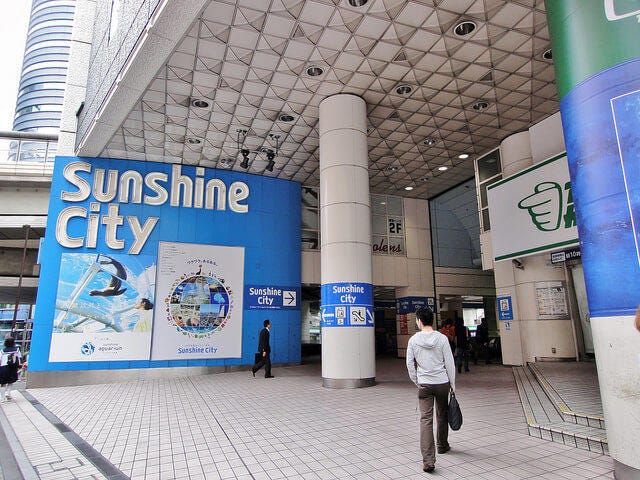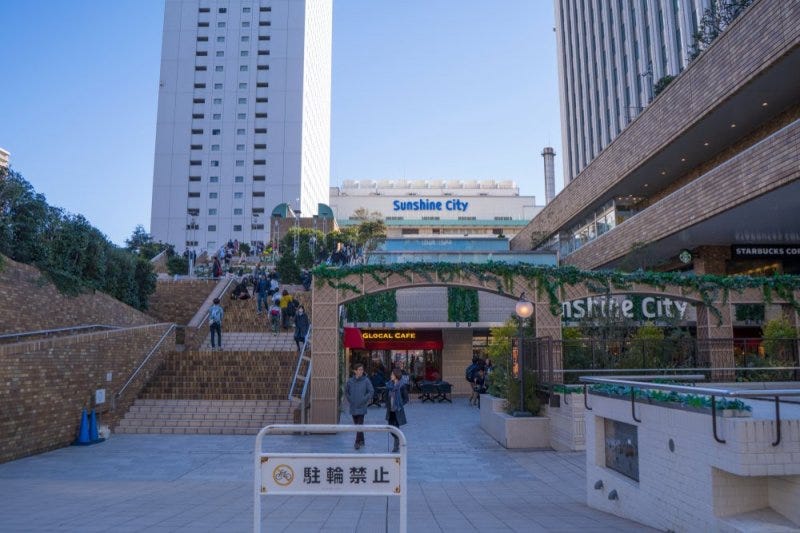Sephonie (2022): Why make a level about Sunshine City?
Melos Han-Tani discusses the historical and character-driven reasons behind why Tokyo’s Sunshine City mall makes an appearance as one of the game’s levels.
Find Melos elsewhere: (Twitter)
Sephonie (2022) is a 3D platformer-puzzler-visual novel I released with Marina Kittaka in 2022. (More on the puzzle aspect in AJE’s last volume). You jump and wall-run through beautiful caverns while controlling 3 scientists and learning about them in unique visual novel-esque scenes. Later, as the game takes a more surreal, dreamy turn, the levels start to resemble places from their lives. In particular, one of the protagonists, Ing-wen, (A Taiwan-born, Taiwanese ethnicity character) finds herself in a vast waterfall cavern with man made structures resembling the Sunshine City mall she once visited with her then-girlfriend, Light.
This is an unusual location for a platformer level! Sunshine City is a very real mall in a very real neighborhood - Ikebukuro - located in Tokyo, Japan. Today I’d like to explain “Why put Sunshine City in Sephonie?” This question overlaps with things ranging from history to the pleasure of a wall-run.
The main motivation for picking this level’s setting was to allow the player to experience a place Ing-wen had actually visited. While she primarily lives in Taiwan, she holds a fondness and nostalgia for her vacations to nearby Japan. In some ways, Japanese popular culture is central to her life. In fact, Japanese culture has had (and still holds) a large influence on Taiwanese popular culture. Further, on a vacation during a past relationship from her younger years with, Light (an Asian woman living in the USA), she once came to Sunshine City. Love, leisure, aspirations… all sorts of things from her life tied her to this seemingly mundane space of a mall.
Perhaps she would daydream, or occasionally think of these memories. In fact, in Sephonie, she does just that. Diving into the depth of the island, the characters’ inner thoughts and compulsions start to manifest themselves as gigantic platforming levels.
In this level, you talk to NPCs that are conversations Ing-wen overheard. You also get to see old conversations between Light and Ing-wen play out. By locating these conversations inside of the actual mall, it allows a player to both experience Ing-wen’s memories, thoughts, and emotions - but against the backdrop of the actual space where she had the experiences that gave birth to such things. The mall, too, is a compelling type of space that was perfect for the type of platforming that Sephonie is built around. Parking garages, ceilings, multi-level atriums…
But why pick Sunshine City? Outside of Ing-wen’s personal attachments to the space, and Taiwan’s relationship to Japan - Sunshine City is a historical mall. It was once Sugamo Prison, holding political prisoners before WW2, and Japanese war criminals after WW2. The prison is the subject of media like Akira Yoshimura’s novels One Man’s Justice (1978) or プリズンの満月 (lit. “Full Moon of the Prison”) (1995). The former follows a prisoner at Sugamo, the latter, a security guard at the prison (and eventually at Sunshine City). Like any military site repurposed into something consumer-focused, there’s symbolism in the site of Sunshine City.
In real life, Ikebukuro is a very commercial neighborhood trendy with cosplayers, BL and anime fans, teens, immigrants, tourists, and more. It appears in all sorts of media: Shin Megami Tensei Nocturne, Train to the End of the World, Ikebukuro West Gate Park, P-Model’s song “Sunshine City”. It’s a place symbolic of aspiration for some, full of dreams. It’s a nostalgic place for others. It’s a place full of excess: the rotted husks of once-arcades, now packed with terrible gambling games like Pachinko, Claw Machines, or this game that costs 100 yen to let you punch something twice.
There’s fast food, host clubs, love hotels, maid cafes, wig stores… and delicious import Chinese Grocery Stores. Movie theatres, Uniqlos, Showa-era bakeries, and a used Game Store that puts the SNES games right next to the hardcore pornography. It’s a place booming with the visuals and sounds of popular culture, for better or worse. Yet, there’s something still understated about it compared to more widely known Tokyo neighborhoods... And then you walk 5 minutes away and it’s a regular neighborhood with old people and families.
I would often visit the mall on my travels to Japan, and more often, once living in Tokyo, when I was living near Ikebukuro. Tokyo is a city that is forever tied to America (being firebombed by it, and then arguably allowed and pushed to rebuild), so with Sephonie I wanted to pull on some of those threads tying together Japan, the USA, WW2, and the relation of Japanese pop media to other Asian countries. Like many Americans, I have a fondness for these shopping malls and their relaxing atmospheres, and knowing their role in upholding postwar society’s consumerist dreams (and how those dreams have shaped me) make them all the more intriguing.
For my bounty, I guess I have two.
I’d love to see more games engaged with 3D space (like platformers) also attempt taking on heavier, complex settings and topics that go beyond the usual cartoon-like fare.
I’d love to see someone make a FASTGAME before me! It’s a type of game that actively engages with the mechanic of “fast-forwarding the game to 4x+ speed”, but not solely for being a “Quality of Life” feature or doing something like skipping text. Rather, it might explore something like the unique gameplay texture of trying to grind somewhere at 4x speed.
Take the reader survey!













